
Electrostatic motors, for which the basic principle hasn’t changed since Franklin built the first practical example, are different. The force in these motors comes not from the movement of electrons but from the attraction and repulsion between negative and positive charges in components—the same type of static charge that gives you a shock when you touch a doorknob after shuffling across the carpet in winter.
Franklin’s original model—which he first demonstrated to the public in 1749 as a rotisserie to cook a turkey—is an illustrative example.
Rather than being pushed by a continuous electromagnetic field, the axle of Franklin’s motor included brass sewing thimbles that had their charge reversed as they passed one of four glass jars that store electric charge, one at each corner of the device. This meant every thimble had either a positive or negative charge, and was therefore attracted to the next glass jar and repelled by the one it just passed. [Wikipedia]

Franklin's electrostatic machine is a high-voltage static electricity-generating device used by Benjamin Franklin in the mid-18th century for research into electrical phenomena. Its key components are a glass globe which turned on an axis via a crank, a cloth pad in contact with the spinning globe, a set of metal needles to conduct away the charge developed on the globe by its friction with the pad, and a Leyden jar – a high-voltage capacitor – to accumulate the charge. Franklin's experiments with the machine eventually led to new theories about electricity and inventing the lightning rod.
See Also
12.01 - Scale of Locked Potentials
12.04 - Locked Potentials and the Square Law
12.27 - Potentials
3.22 - Quantum Leap Delta equivalent to Locked Potentials Delta
Apparatus For Producing Electric Currents of High Frequency and Potential - 568176
Chart of Locked Potentials - See Also
Chart of Locked Potentials
cold multiplies electric potential
coupled potential gradient
CURRENT-FREE POTENTIAL
curvature of electric potential pressure
depotentialization
difference tone
difference
electric potential difference
electric potential
electromagnetic potential
electrostatic attraction
electrostatic compressional energy
electrostatic force
electrostatic molecular force
electrostatic potential difference
electrostatic scalar potential
electrostatic strain
equipotential environments
fast motion multiplies electric potential
Figure 12.04 - Locked Potential Points Relations and Descriptions
Figure 12.10 - Russells Locked Potential Wave
Figure 12.11 - Russells Locked Potential Full Ten Octave Gamut
Figure 3.13 - Orthogonal Vector Potentials
Figure 3.5 - Conflicting and Opposing Vector Potentials
Figure 8.6 - Difference Tones
Figure 9.12 - Scale of Locked Potentials over Time
Franklins Electrostatic Motor
heat divides electric potential
Kelvin water dropper
Laws of Electrostatic Induction
Locked Potentials and Subdivisions
Locked Potentials and the Square Law
magnetostatic scalar potential
multiplication of electric potential
naturalesque potential difference
omni-Magnetic-potential
Part 12 - Russells Locked Potentials
potential density
potential gradient
Potential
potentialization
potentialize
rings of electric potential
scalar electromagnetic potential
Scalar Potential
Scale of Locked Potentials
static
stress potential wave
Vector Potential
zero electric potential
zero potential holes
